Rancho Cucamonga, CA Pollen and Allergy Report for Summer 2023
Pollen Allergy Trends in Rancho Cucamonga, CA
When is pollen lowest in Rancho Cucamonga, CA?

February
Lowest month total PPM
Avg. PPM
When is pollen highest in Rancho Cucamonga, CA?

March
Highest month total PPM
Avg. PPM
How does pollen in Rancho Cucamonga, CA compare to California?
Rancho Cucamonga has a lower average PPM than the state of California.
Rancho Cucamonga yearly avg PPM:
California yearly avg PPM:
How does pollen in Rancho Cucamonga, CA compare to the USA?
Rancho Cucamonga has a lower average PPM than the USA.
Rancho Cucamonga yearly avg PPM:
USA yearly avg PPM:
Is pollen worse this year in Rancho Cucamonga, CA?
Spring 2023 was better than spring 2022.
Spring 2023 PPM:
Spring 2022 PPM:
Average PPM in Rancho Cucamonga, CA


Rancho Cucamonga, CA Pollen and Allergy Breakdown by Month
Grass
When is grass pollen highest in Rancho Cucamonga, CA?
May has the highest grass pollen in Rancho Cucamonga, CA with an average PPM of
When is grass pollen lowest in Rancho Cucamonga, CA?
December has the lowest grass pollen in Rancho Cucamonga, CA with an average PPM of
Tree
When is tree pollen highest in Rancho Cucamonga, CA?
March has the highest tree pollen in Rancho Cucamonga, CA with an average PPM of
When is tree pollen lowest in Rancho Cucamonga, CA?
August has the lowest tree pollen in Rancho Cucamonga, CA with an average PPM of
Weed
When is weed pollen highest in Rancho Cucamonga, CA?
November has the highest weed pollen in Rancho Cucamonga, CA with an average PPM of
When is weed pollen lowest in Rancho Cucamonga, CA?
February has the lowest weed pollen in Rancho Cucamonga, CA with an average PPM of
Rancho Cucamonga, CA Pollen Monthly Breakdown by Pollen Type




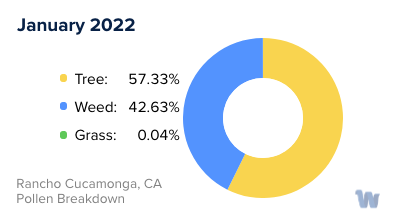
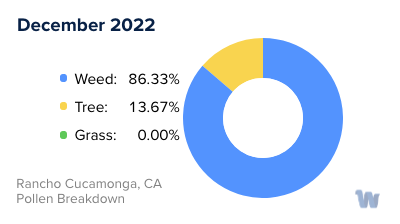


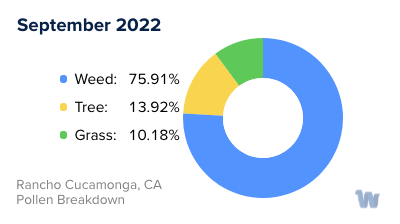
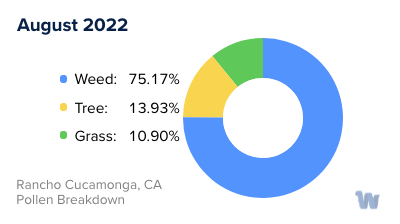
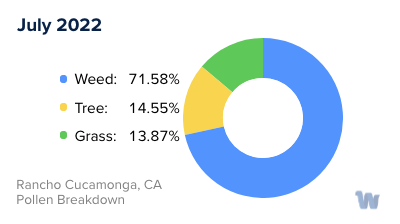
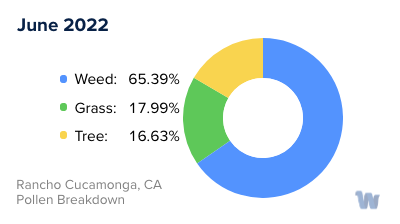


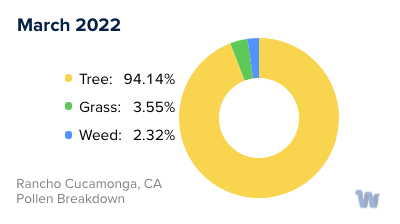
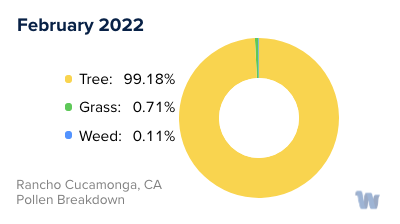
Pollen and Hay Fever in Rancho Cucamonga, CA
Rancho Cucamonga, a city nestled in the state of California, experiences its share of pollen allergies, often referred to as hay fever. The city's mild climate and geographic location influence the types of pollen that affect its inhabitants and the seasons during which they are most prevalent.
Pollen allergies typically arise from three main types of plants: grasses, trees, and weeds. In the city of Rancho Cucamonga, tree pollen is a common offender. The city's tree population, which includes varieties such as oak, cedar, and eucalyptus, among others, plays a significant role in the allergy landscape.
Contrary to the notion that allergies are only a seasonal issue, it's important to remember that depending on the specific allergen, individuals can experience symptoms at any time of the year. However, pollen allergies tend to flare up most notably in the spring, summer, and fall.
The allergy season in California typically commences around late January, with the onset of spring. The milder winters in the state allow for an earlier start to the allergy season compared to some other regions. Notably, the pollen counts peak in April, May, and September, thus these months might be particularly challenging for those who are sensitive.
Despite the extended allergy season, California's coastal climate might offer some relief compared to other states with similar weather conditions, as the pollen counts are generally lower. The allergy season usually concludes in October or November, providing residents a respite before the cycle begins anew with the advent of the next spring.
While the winter season offers a break from outdoor allergens, indoor allergens can still cause issues, particularly as people tend to spend more time indoors during this season. It is, therefore, crucial to be aware of both outdoor and indoor allergens for a comprehensive understanding of allergy management.
In conclusion, while the pleasant city of Rancho Cucamonga offers many attractions, its residents must navigate the challenges posed by pollen allergies, especially during the peak months. Being aware of the types of pollen and the timing of their prevalence can be a crucial step in managing these allergies effectively.


